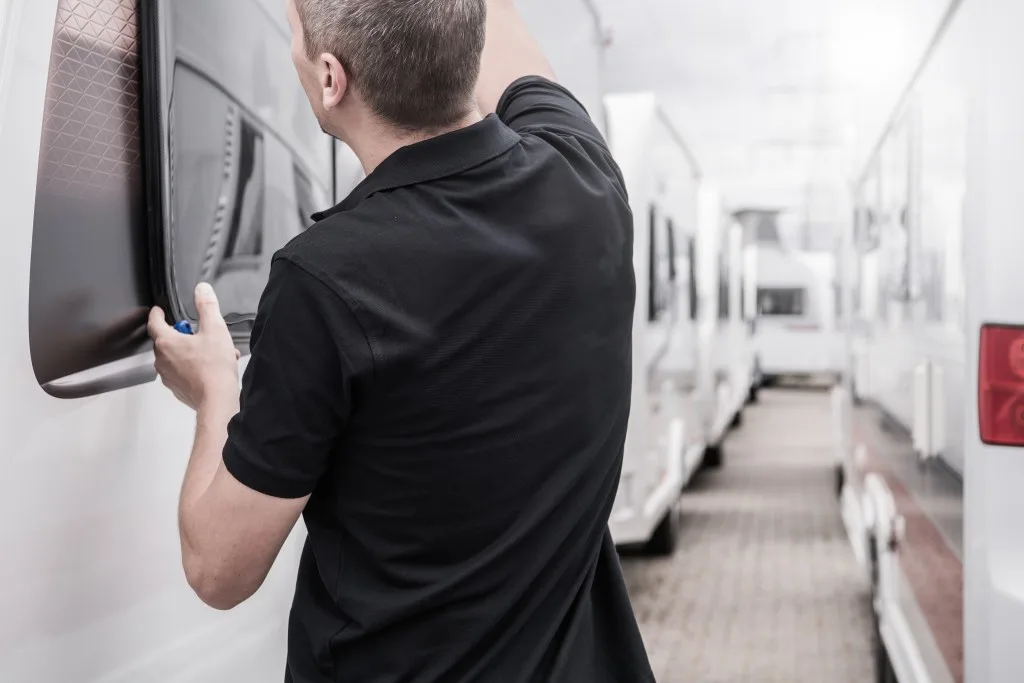Do Fiberglass Campers Leak?
Fiberglass is a popular building material used in the construction of many RVs and campers on the road today. With water damage being on the mind of every RVer, new or seasoned, it’s normal to wonder: do fiberglass campers leak?
There are different types and styles of fiberglass campers. In this article, we look at each type of fiberglass RV and answer the question: do they leak? If so, where… and how do you prevent it?
Let’s dig in!
Spill the Tea
All campers have the potential to leak, no matter what material they’re made out of. Fiberglass campers included!
There are different kinds of fiberglass campers, and some are more prone to leaking than others. Let’s break down the types of fiberglass campers.
Types of Fiberglass Campers
There are two main types of fiberglass campers: molded fiberglass campers, and campers with fiberglass siding. We’ll break down the differences here.

Molded Fiberglass
Molded fiberglass campers include campers from brands like Scamp and Casita. These are called molded fiberglass trailers because they are made out of two pieces of molded fiberglass, fused together at a seam running down the middle. There is a top piece and a bottom piece, and they’re joined at about waist height.
Do Molded Fiberglass Campers Leak?
Molded fiberglass campers can leak, but they’re not as prone to leaking as campers with fiberglass siding.
Since molded fiberglass trailers are joined on the sides of the camper, there are no large seams running along the roof.
Typically, seams and points where pieces join together are the most prone to leaking. But molded campers do have potential leak points even though they don’t have large roof seams! Anywhere there is a hole in the fiberglass for an appliance, vent, wire, or window, there is a potential for a leak.
Common spots for molded fiberglass campers to leak are around roof vents, air conditioners, and window seams.

Fiberglass Siding
Many campers on the road today are made out of wood or metal beams with fiberglass siding. In fact, fiberglass is a sturdy and lightweight building material that makes a sleek-looking RV exterior.
Other types of RV siding include corrugated aluminum, like some older travel trailers and motorhomes, or smooth aluminum like you see on Airstreams.
Pro Tip: There are multiple options when it comes to siding for your RV. Here is how to know: What Type of RV Siding Should You Avoid?
Do Campers with Fiberglass Siding Leak?
Yes, campers with fiberglass siding leak. This is a common issue for every camper. It’s also an important preventative maintenance task for all RV owners.
Motorhomes and camping trailers are constantly moving and shaking. This can cause a variety of issues, including leaks. Constant movement and damage from UV rays can cause seams to split open and seals to crack, introducing places for rain and moisture to seep in.
Let’s take a look at common leak spots on campers with fiberglass siding.

Common Leak Spots on Fiberglass Siding Campers
Seams and seals are the most important spots to check on a camper with fiberglass siding. Seams are anywhere two pieces of material come together. All seams are sealed with sealant or sealant tape, but these sealants fail over time.
Movement can cause seals to split open, and UV rays can cause the sealant material to dry out and crack. Even a crack as small as a piece of hair is enough to cause a big issue when it comes to water damage.
Common spots for leaks are anywhere along the roof where there is a seam, air conditioner, roof vent, or wire entry point.
Other common areas for leaks on fiberglass campers are around slide-outs and windows.
Fiberglass Camper Delamination
Delamination occurs when water or moisture penetrates the exterior of the camper and gets between the fiberglass siding and the internal RV structure. From the outside, delamination looks like bubbles or ripples on the surface of the RV.
Delamination is more than just unsightly: it often indicates a much larger problem. From rotting wood to toxic mold, delamination can be a key giveaway to water damage in an RV.
Where to Look for Water Damage in a Fiberglass Camper
Since fiberglass campers are prone to leaking, it is prudent to inspect any potential purchase for leaks and water damage.
Check for soft spots on the floor near sinks, showers, toilets, under windows, and along walls. Check walls and ceilings for soft spots around windows, air conditioners, and roof vents. Inspect walls and floors around slide-outs for soft spots, as well.
Other places to look for water damage include discolored spots on the ceiling and inside cabinets.
Pro Tip: Like the look of a fiberglass camper? Here are the 5 Best Fiberglass Camper Trailers (with Bathrooms)

Preventative Maintenance for Fiberglass Camper Leaks
Since all campers have the potential to leak, all campers have the potential to have water damage. The best way to avoid water damage is to do regular preventative maintenance.
Regularly inspect your RV roof and check all seams and seals for cracking and peeling. Most RV sealant maintains a soft or rubber consistency. If your sealant has started to dry out and become hard, it will be prone to cracking and needs to be resealed.
Keep slide-out seals clean and coated with slide-out protectant to keep them working smoothly and preventing leaks.
Regularly inspect your RV windows for leaks, too! Tree branches and hail can cause leaks in your camper, as well, with as much as a pinhole-sized poke, crack, or tear.
All Campers Can Leak
All campers have the potential to leak, but that doesn’t mean that they have to. Water damage is something no RVer wants to deal with, but it’s important to educate yourself on how it happens, where to spot it, and how to prevent it.
With routine inspection and preventative maintenance, you can avoid a leaking fiberglass camper and save yourself the hassle of dealing with RV water damage. Have you had a leak in your fiberglass camper?
Discover the Best Free Camping Across the USA
To be honest with you, we hate paying for camping. There are so many free campsites in America (with complete privacy).
You should give it a try!
As a matter of fact, these free campsites are yours. Every time you pay federal taxes, you’re contributing to these lands.
Become a FREE CAMPING INSIDER and join the 100,000 campers who love to score the best site!
We’ll send you the 50 Best Free Campsites in the USA (one per state). Access the list by submitting your email below:
Every window, yes EVERY WINDOW, leaked in our 1974 Boler. If you have an older fibreglass trailer, plan on resealing all the windows.
Our 2005 Casita never leaks EXCEPT when a window is left open in the rain. The water flows off the roof RIGHT INTO THE window and soaks everything. So be very mindful and close the windows. We installed a roof vent cover so we can keep the vent open even when it rains.